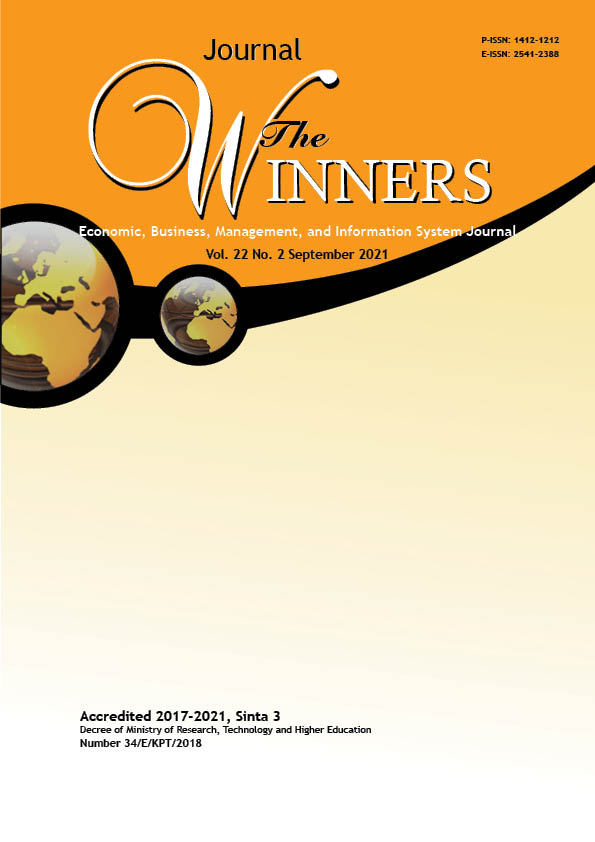Factors Affecting Online Donation Intention in Donation-based Crowdfunding
DOI:
https://doi.org/10.21512/tw.v22i2.7101Keywords:
online donations, donation intention, crowdfundingAbstract
The research aimed to determine factors affecting online donation intention of Generation Y, particularly in donation-based crowdfunding in Indonesia. Applying a quantitative method, the research used a combination of Theory of Planned Behavior (Attitude, Subjective Norms, Perceived Behavioral Control), Social Presence Theory, and S-O-R Theory (Website Quality, Transaction Convenience, Perceived Credibility). The research used purposive sampling with total of 118 respondents. The result of the analysis suggests that millennials’ intention to donate is significantly affected by the perceived credibility of the crowdfunding platform. This is mainly due to online transaction, hence the donors are concerned about whether their donation is going to be distributed properly. Subsequently, the perceived credibility of crowdfunding platform is significantly affected by social presence, website quality, and transaction convenience, which support previous research related to Social Presence Theory and S-O-R Theory. Meanwhile, attitude, subjective norms, and perceived behavioral control have no significant impact on intention to donate, which may be due to several issues such as trust and security issues considering the donation is conducted through online. The crowdfunding platforms and fundraisers in Indonesia are expected to have guidelines about important aspects that may affect individual’s intention to donate in crowdfunding platform.
References
Ahlers, G. K. C., Cumming, D., Günther, C., & Schweizer, D. (2015). Signaling in equity crowdfunding. Entrepreneurship Theory and Practice, 39(4), 955–980. https://doi.org/10.1111%2Fetap.12157
Ajzen, I. (1991). The theory of planned behavior. Organizational Behavior and Human Decision Processes, 50(2), 121–179. https://doi.org/10.1016/0749-5978(91)90020-T
APJII. (2020). Laporan Survei Internet APJII 2019 – 2020. Asosiasi Penyelenggara Jasa Internet Indonesia, 2020, 1–146. https://apjii.or.id/survei
Bukhari, F. A. S., Usman, S. M., Usman, M., & Hussain, K. (2019). The effects of creator credibility and backer endorsement in donation crowdfunding campaigns success. Baltic Journal of Management, 15(2), 215-235. http://dx.doi.org/10.1108/BJM-02-2019-0077
Chen, M.-F. & Tung, P.-J. (2014). Developing an extended theory of planned behavior model to predict consumers’ intention to visit green hotels. International Journal of Hospitality Management, 36, 221–230. https://psycnet.apa.org/doi/10.1016/j.ijhm.2013.09.006
Chen, Y., Dai, R., Yao, J., & Li, Y. (2019). Donate time or money? The determinants of donation intention in online crowdfunding. Sustainability, 11(16). https://doi.org/10.3390/su11164269
Cheung, M., Luo, C., Sia, C., & Chen, H. (2009). Credibility of electronic word-of-mouth: Informational and normative determinants of on-line consumer recommendations. International Journal of Electronic Commerce, 13(4), 9–38. https://doi.org/10.2753/JEC1086-4415130402
Choi, J., Lee, H. J., & Kim, Y. C. (2011). The influence of social presence on customer intention to reuse online recommender systems: The roles of personalization and product type. International Journal of Electronic Commerce, 16(1), 129–154. https://doi.org/10.2753/JEC1086-4415160105
Choi, S. (2016). The flipside of ubiquitous connectivity enabled by smartphone-based social networking service: Social presence and privacy concern. Computers in Human Behavior, 65, 325–333. http://dx.doi.org/10.1016/j.chb.2016.08.039
Choy, K. & Schlagwein, D. (2016). Crowdsourcing for a better world: On the relation between IT affordances and donor motivations in charitable crowdfunding. Information Technology & People, 29(1), 221–247. https://doi.org/10.1108/ITP-09-2014-0215
Cooper, D. R. & Schindler, P. S. (2014). Business Research Methods (12th Ed.). McGraw-Hill Higher Education.
Deloitte. (2019). Millennials in Industry 4.0: A Gift or a Threat to Indonesian Human Resources? (1st Ed.). Deloitte Indonesia. https://www2.deloitte.com/content/dam/Deloitte/id/Documents/about-deloitte/id-about-dip-edition-1-chapter-2-en-sep2019.pdf
Gefen, D. & Straub, D. W. (2004). Consumer trust in B2C e-commerce and the importance of social presence: Experiments in e-products and e-services. Omega, 32(6), 407–424. https://doi.org/10.1016/j.omega.2004.01.006
Gerber, E. M. & Hui, J. (2013). Crowdfunding: Motivations and deterrents for participation. ACM Transactions on Computer-Human Interaction, 20(6). https://doi.org/10.1145/2530540
Gregg, D. G. & Walczak, S. (2010). The relationship between website quality, trust and price premiums at online auctions. Electronic Commerce Research, 10(1), 1–25. https://doi.org/10.1007/s10660-010-9044-2
Han, H. & Kim, Y. (2010). An investigation of green hotel customers’ decision formation: Developing an extended model of the theory of planned behavior. International Journal of Hospitality Management, 29(4), 659–668. http://dx.doi.org/10.1016/j.ijhm.2010.01.001
Indonesia negara paling dermawan di dunia. (2018, December 31). Kitabisa.com. https://blog.kitabisa.com/kitabisa-online-giving-report-2018-indonesia/
Kemenpppa. (2018). Profil Generasi Milenial Indonesia. Kementerian Pemberdayaan Perempuan dan Perlindungan Anak. https://kemenpppa.go.id/lib/uploads/list/9acde-buku-profil-generasi-milenia.pdf.
Kim, J. & Lennon, S. J. (2013). Effects of reputation and website quality on online consumers’ emotion, perceived risk and purchase intention. Journal of Research in Interactive Marketing, 7(1), 33-56. https://doi.org/10.1108/17505931311316734
Kim, S. & Stoel, L. (2004). Dimensional hierarchy of retail website quality. Information & Management, 41(5), 619–633. https://doi.org/10.1016/j.im.2003.07.002
Knowles, S. R., Hyde, M. K., & White, K. M. (2012). Predictors of young people’s charitable intentions to donate money: An extended theory of planned behavior perspective. Journal of Applied Social Psychology, 42(9), 2096–2110. https://doi.org/10.1111/j.1559-1816.2012.00932.x
Kopernik. (2020). Gopay Digital Donation Outlook 2020. https://v1.kopernik.info/documents/document/1608187207118_8549.pdf.
Kotchen, M. J. & Reiling, S. D. (2000). Environmental attitudes, motivations, and contingent valuation of nonuse values: A case study involving endangered species. Ecological Economics, 32(1), 93–107. https://doi.org/10.1016/S0921-8009(99)00069-5
Liu, L., Suh, A., & Wagner, C. (2018). Empathy or perceived credibility? An empirical study on individual donation behavior in charitable crowdfunding. Internet Research, 28(3), 623–651. http://10.0.4.84/IntR-06-2017-0240.
Lu, B., Fan, W., & Zhou, M. (2016). Social presence, trust, and social commerce purchase intention: An empirical research. Computers in Human Behavior, 56, 225–237. http://dx.doi.org/10.1016/j.chb.2015.11.057
Mehrabian, A. & Russell, J. A. (1973). A measure of arousal seeking tendency. Environment and Behavior, 5(3), 315-333. https://psycnet.apa.org/doi/10.1177/001391657300500303
Paul, J., Modi, A., & Patel, J. (2016). Predicting green product consumption using theory of planned behavior and reasoned action. Journal of Retailing and Consumer Services, 29, 123–134. https://econpapers.repec.org/scripts/redir.pf?u=https%3A%2F%2Fdoi.org%2F10.1016%252Fj.jretconser.2015.11.006;h=repec:eee:joreco:v:29:y:2016:i:c:p:123-134
Pratama, A. H. (2017, February 2). Gagal sukseskan banyak proyek, situs crowdfunding wujudkan hentikan layanan. Techinasia. https://id.techinasia.com/situs-crowdfunding-wujudkan-tutup-layanan-pada-31-maret-2017
Putri, V. M. (2020, May 20). Dompet digital dan donasi online munculkan tren micro giving. detikinet. https://inet.detik.com/cyberlife/d-5022821/dompet-digital-dan-donasi-online-munculkan-tren-micro-giving.
Riana, F. (2020, May 15). Total donasi di Kitabisa.com mencapai Rp 130 miliar saat pandemi. Tempo.co. https://nasional.tempo.co/read/1342578/total-donasi-di-kitabisa-com-mencapai-rp-130-miliar-saat-pandemi
Richard, D. M., Dawes, M. A., Mathias, C. W., Acheson, A., Hill-Kapturczak, N., & Dougherty, D. M. (2009). L-tryptophan: basic metabolic functions, behavioral research and therapeutic indications. International Journal of Tryptophan Research, 23(2), 45-60. https://doi.org/10.4137/ijtr.s2129
Sekaran, U. & Bougie, R. (2016). Research Methods for Business: A Skill Building Approach. John Wiley & Sons.
Srivastava, S. C. & Chandra, S. (2018). Social presence in virtual world collaboration: An uncertainty reduction perspective using a mixed methods approach. MIS Quarterly, 42(3), 779–804. https://doi.org/10.25300/MISQ/2018/11914
Sura, S., Ahn, J., & Lee, O. (2017). Factors influencing intention to donate via social network site (SNS): From Asian’s perspective. Telematics and Informatics, 34(1), 164–176. https://doi.org/10.1016/j.tele.2016.04.007
Teng, Y.-M., Wu, K.-S., & Liu, H.-H. (2015). Integrating altruism and the theory of planned behavior to predict patronage intention of a green hotel. Journal of Hospitality & Tourism Research, 39(3), 299–315. https://doi.org/10.1177%2F1096348012471383
Tenkasi, R. R. V. & Zhang, L. (2018). A test of the theory of planned behavior: Influencing behavioral change to go “Greenâ€. Research in Organizational Change and Development, 26, 127-165. https://doi.org/10.1108/S0897-301620180000026004
Vismara, S. (2019). Sustainability in equity crowdfunding. Technological Forecasting and Social Change, 141, 98–106. https://doi.org/10.1016/j.techfore.2018.07.014
Webb, D. J., Green, C. L., & Brashear, T. G. (2000). Development and validation of scales to measure attitudes influencing monetary donations to charitable organizations. Journal of the Academy of Marketing Science, 28(2), 299–309. https://psycnet.apa.org/doi/10.1177/0092070300282010
Downloads
Published
How to Cite
Issue
Section
License
Copyright (c) 2021 Irantha Hendrika Kenang, Gladys Gosal

This work is licensed under a Creative Commons Attribution-ShareAlike 4.0 International License.
Authors who publish with this journal agree to the following terms:
a. Authors retain copyright and grant the journal right of first publication with the work simultaneously licensed under a Creative Commons Attribution License - Share Alike that allows others to share the work with an acknowledgment of the work's authorship and initial publication in this journal.
b. Authors are able to enter into separate, additional contractual arrangements for the non-exclusive distribution of the journal's published version of the work (e.g., post it to an institutional repository or publish it in a book), with an acknowledgment of its initial publication in this journal.
c. Authors are permitted and encouraged to post their work online (e.g., in institutional repositories or on their website) prior to and during the submission process, as it can lead to productive exchanges, as well as earlier and greater citation of published work.
USER RIGHTS
All articles published Open Access will be immediately and permanently free for everyone to read and download. We are continuously working with our author communities to select the best choice of license options, currently being defined for this journal as follows: Creative Commons Attribution-Share Alike (CC BY-SA)

















